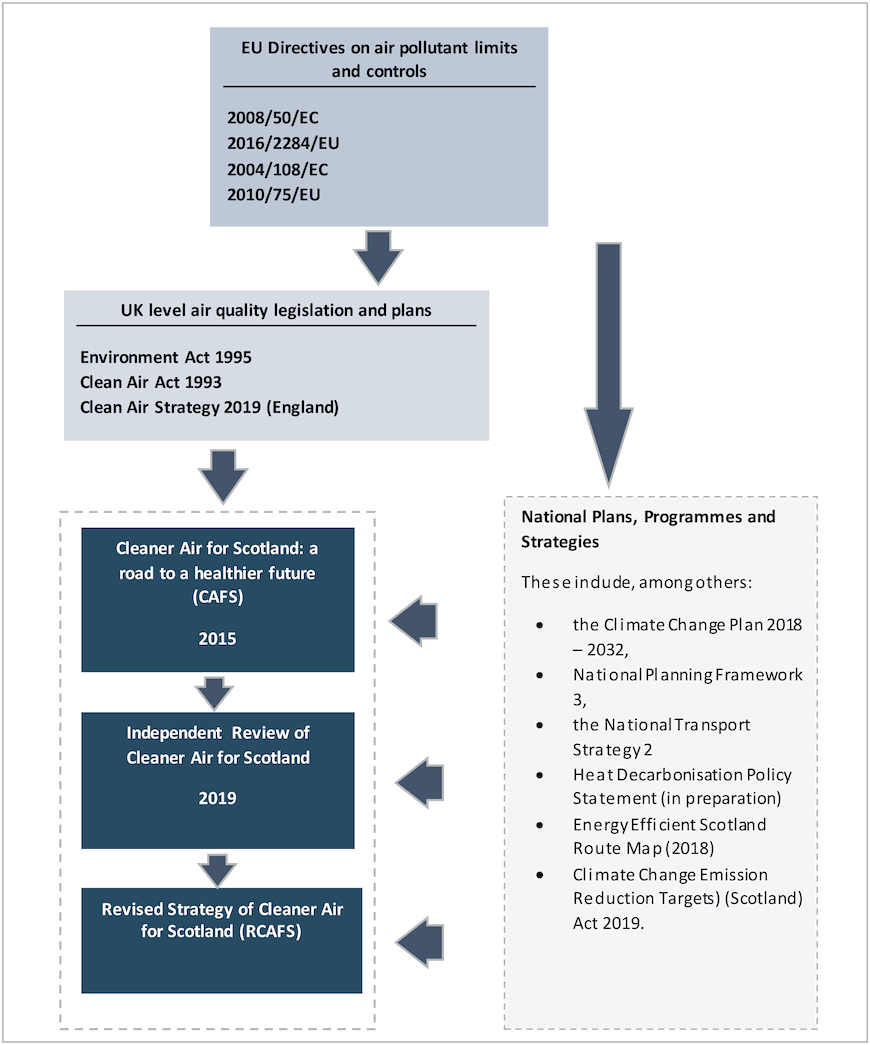Cleaner Air for Scotland 2: environmental report
An Environmental Report to assess the likely significant environmental impacts of the new air quality strategy.
1. Cleaner Air for Scotland 2 Strategy (CAFS2)
1.1. Introduction
1.1.1 In November 2015, the Scottish Government published ‘Cleaner Air for Scotland – The Road to a Healthier Future’ (CAFS)[2]. This was the first Scottish air quality strategy separate from the rest of the UK and sought to bring together the major policy areas relevant to air quality - climate change, transport, planning, health and energy - within one overarching framework. The strategy set out around 40 actions relating to these policy areas, with the primary focus being on urban air quality, and also covers the Local Air Quality Management (LAQM) system.
1.1.2 The majority of these 40 actions, as well as several additional actions not included at the time of publication, have now been completed. Some of these are still ongoing and will be taken forward in parallel with the actions outlined in the draft Cleaner Air for Scotland 2 (CAFS2).
1.1.3 In November 2018, the Cabinet Secretary for the Environment, Climate Change and Land Reform commissioned an independently led review of CAFS. The purpose of the review was twofold - firstly to assess progress to date in implementing the actions contained in the strategy and secondly to identify priorities for additional actions to deliver further air quality improvements.
1.1.4 The review was overseen by a steering group and supported by four specialist working groups covering health & environment, placemaking, agricultural, domestic & industrial emissions and transport. The steering group submitted its final report to the Scottish Government in July 2019 setting out a series of conclusions and recommendations[3]. Between October and December 2019, an online survey allowed individuals and organisations to submit their views on the recommendations. Both the review findings and these wider views were used to inform the development of the draft CAFS2.
1.1.5 The consultation draft CAFS2 recognises that air pollution, climate change, carbon reduction, and mobility are strongly interconnected. Whilst this is evident in CAFS (2015), which focused on air quality and particularly transport as the largest source of urban air quality issues, the draft CAFS2 expands on this to include other sources and the wider issues of air pollution, such as agriculture and domestic combustion. It also emphasises the importance of policy integration and implementation at both the national and local level.
1.1.6 The draft CAFS2 is centred around 10 themes, reflecting the high level recommendations arising from the CAFS independent review. Each of these are underpinned by specific actions as illustrated in Table 1 below.
1.1.7 Finally, and notably during the drafting process for CAFS2, the COVID-19 pandemic has changed the way we work, socialise and travel in Scotland. These unprecedented changes in living and working patterns are likely to have had a significant, but as yet unquantified, effect on air pollution. Monitoring data show that during the main lockdown period ambient nitrogen dioxide (NO2) concentrations were lower than expected for the time year, which is attributed to a decrease in road transport emissions. Since then, concentrations have started to increase again. Further opportunities to support positive environmental changes will help the Scottish Government meet its climate change targets and improve air quality, whilst supporting economic recovery.
Table 1. CAFS2 Structure
1. Health – a precautionary approach
Actions that focus on assessing and commissioning research on health impacts associated with air pollution.
2. Integrated policy
Actions that focus on existing policy integration across sectors to support the delivery of co-benefits for air quality.
3. Placemaking
Actions that focus on embedding air quality improvements in plans and polices such as the Place Standard.
4. Data
Actions that focus on research to improve current air quality data.
5. Public Engagement and Behaviour Change
Actions focus on the development of a public engagement strategy on air quality in Scotland and the undertaking of a baseline survey of current public awareness of air pollution health effects and source contributors.
6. Industrial Emissions regulations
Actions that focus on the continuing application of existing EU air standards and themes and explore potential additional measures (i.e. industrial emissions).
7. Tackling non-transport emissions sources
Domestic combustion
Actions that focus on educational incentives and encouraging the reduction of air pollution associated with domestic combustion.
Introduction of legislation to control the supply of the most polluting domestic fuels.
Agricultural emissions, nitrogen deposition and environmental impacts
Actions to support agricultural emission reduction including a voluntary code of good agricultural practice, as well as review, investigation and monitoring of nitrogen deposition and environmental impacts.
9. Governance, accountability and delivery
Actions focus on effective governance and joined up delivery of the draft CAFS2.
8. Transport
Actions to introduce Low Emission Zones into Scotland’s four largest cities (Edinburgh, Glasgow, Dundee and Aberdeen), minimise travel and support active travel, as well as ensure public transport provision.
10. Further progress review
Action focus on reviewing progress on actions identified by the draft CAFS2 and ensuring further developments, challenges and actions can be identified.
1.1.8 The draft CAFS2’s high level policy context is included in Figure 1 below. Further detail of the relationship between CAFS2 and other relevant Plans, Polices and Programmes is also included in Section 3.4.

Contact
Email: andrew.taylor2@gov.scot
There is a problem
Thanks for your feedback